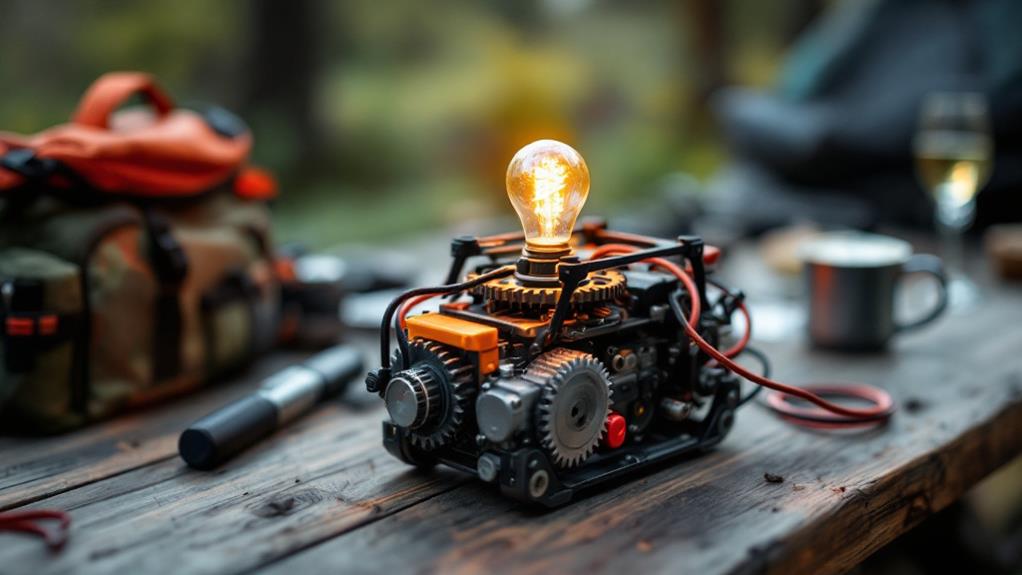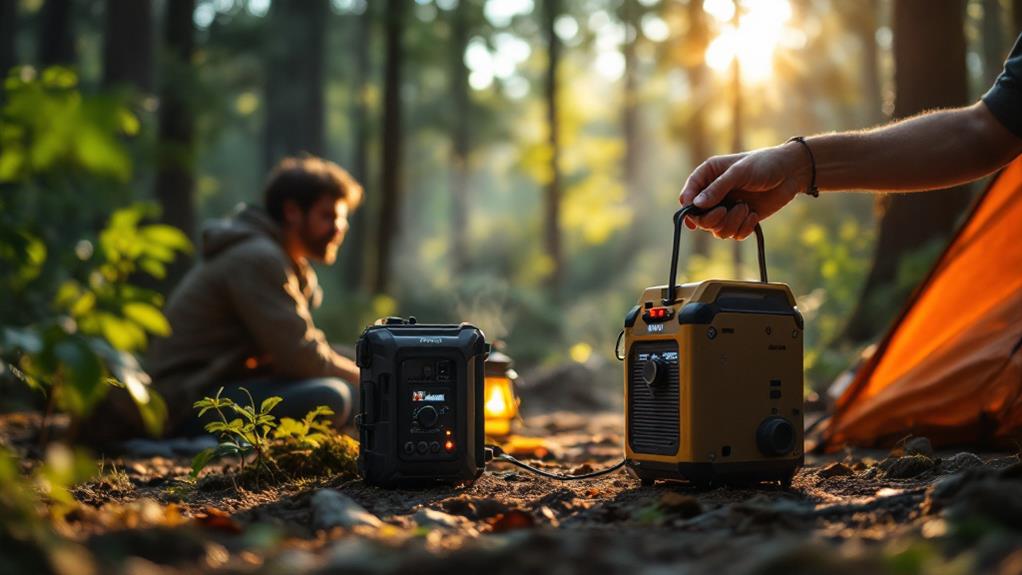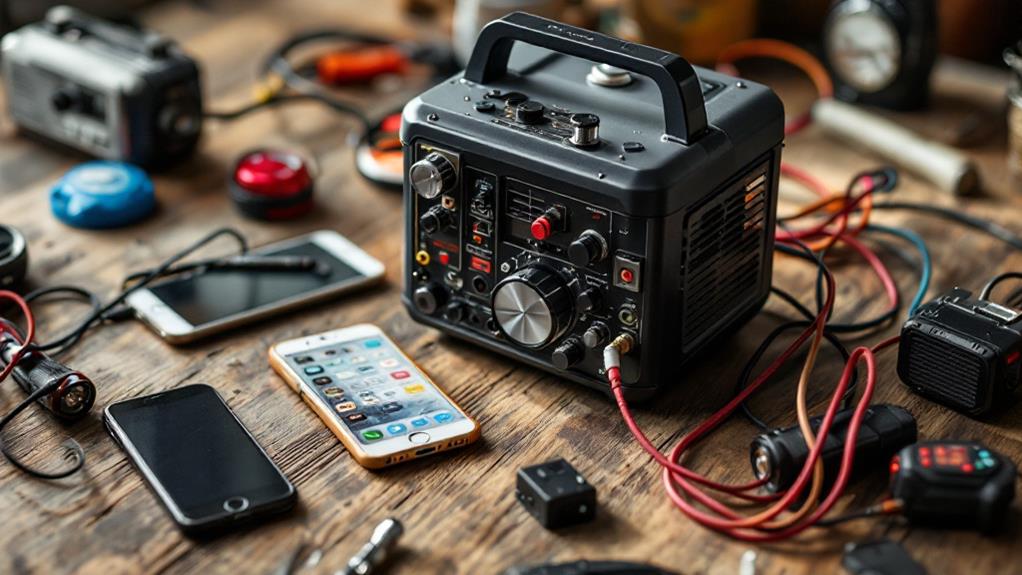What Is a Portable Crank Generator and How Does It Work? A Comprehensive Guide

A portable crank generator is a compact powerhouse that transforms your physical effort into electrical energy. By turning the crank handle, you start a series of gears that speed up rotation, causing a rotor to spin within a wire coil. This movement generates a magnetic field, pushing electrons and producing electric current. Without needing fuel or a power outlet, it's a sustainable option for charging devices during outages or outdoor adventures. These versatile gadgets are easy to store and come with features like USB ports or flashlights. Investigate further to find out the best model and use tips for your needs.
Understanding Portable Crank Generators
In regard to understanding portable crank generators, it's all about realizing their practical use and versatility. These devices have come a long way, evolving from basic mechanical contraptions to modern portable energy solutions that offer convenience and reliability. You might be curious about the crank generator history, which dates back to the early 20th century when hand-cranked devices initially emerged. They were initially used in military applications and emergency communication systems, providing a vital energy source when other options were unavailable.
Fast forward to today, and you'll find that portable crank generators are an indispensable part of camping gear, emergency kits, and even educational tools. They're designed to be user-friendly, offering you a dependable backup power source when you're off the grid or during power outages. By simply turning a crank, you can generate electricity, making it possible to charge small electronic devices or power important equipment. These generators are a reflection of human ingenuity, bridging the gap between historical mechanical power and contemporary portable energy solutions. Understanding their history and applications gives you a deeper appreciation of their role in our tech-driven world.
How Crank Generators Function
Having investigated the rich history and applications of portable crank generators, let's now uncover the mechanics behind their operation. At the heart of a crank generator is the process of converting mechanical energy into electrical energy. When you turn the crank handle, you're manually generating mechanical energy. This energy is transferred into a series of gears that increase the rotational speed.
The increased speed is vital because it drives the generator's rotor, located inside a coil of wire. As the rotor spins, it creates a magnetic field inside the coil. This movement is what initiates the energy conversion process, transforming mechanical energy into electrical energy. The flow of electrons through the wire generates a current, which can then be used to power electronic devices or stored in a battery for later use.
You control this entire process simply by cranking the handle at a consistent pace. The faster you turn the crank, the more mechanical energy you produce, and subsequently, the more electrical energy is generated. Fundamentally, crank generators are a demonstration of the power of simple, hands-on energy conversion, transforming your physical effort into usable electricity.
Advantages of Crank Generators

The allure of crank generators lies in their simplicity and reliability. With just a bit of manual effort, you can generate power without the need for fuel or electricity. You're not just saving money; you're also contributing to a greener planet. The sustainability benefits are clear—by using a crank generator, you're reducing reliance on non-renewable energy sources and diminishing your carbon footprint. It's a small step, but every effort counts in the larger scheme of environmental conservation.
Crank generators are incredible tools for emergency preparedness. Imagine you're in a situation where the power's out, and your phone is dead. A crank generator can be a lifesaver, providing you with the critical power you need to stay connected and informed. They're compact and easy to store, making them a perfect supplement to your emergency kit. No matter where you are, as long as you have the strength to turn the crank, you've got access to power.
Versatility is another advantage, as these generators can charge a range of devices, from phones to small lights. They're your reliable power source when you're off the grid or facing unexpected outages.
Choosing the Right Model
In selecting the perfect crank generator, you'll want to contemplate several key factors to make the best choice. Start by considering the generator's power output. Determine how much energy you need to charge your devices or power gadgets during an emergency. Look for models that offer adjustable outputs if you plan to use multiple devices. Portability is another feature to weigh. If you plan to carry it on long hikes or store it in a compact space, choose a lightweight and compact design.
When choosing features, evaluate supplementary functionalities like built-in flashlights or USB ports that can add versatility. Some models might include radios or solar panels, which can be beneficial in different situations. Durability is vital, especially if you expect rugged use or exposure to harsh conditions. Sturdy, weather-resistant materials are a must.
Comparing brands can also guide your decision. Look for reputable manufacturers known for quality and reliability. Customer reviews and ratings can provide insights into real-world performance and potential issues. It's wise to balance cost with features, ensuring you get the best value. By thoughtfully considering these aspects, you'll secure a crank generator tailored to your needs.
Tips for Effective Use

After selecting the ideal crank generator, optimize its potential by adopting smart usage practices. Initially, verify you follow crucial safety precautions. Always operate your generator on a stable, flat surface to prevent accidental tipping. Keep your hands dry while cranking to avoid slipping, which could lead to injury. Ascertain the area around the generator is free from flammable materials, as this minimizes fire risks.
Next, familiarize yourself with proper maintenance tips to extend your generator's lifespan. Regularly inspect the crank handle and all moving parts for wear and tear. Lubricate them as needed to guarantee smooth operation. Check the generator's cables and connections for any signs of damage. If you spot frayed wires, replace them immediately to maintain efficiency and safety.
Store your generator in a dry, cool place when not in use. Humidity and extreme temperatures can affect its performance and durability. Before storing, clean the generator to remove any dirt or debris that might have accumulated during use.
Lastly, practice cranking your generator periodically, even if you don't need to use it. This keeps the internal components in good working order, assuring it's ready when you need it most.



